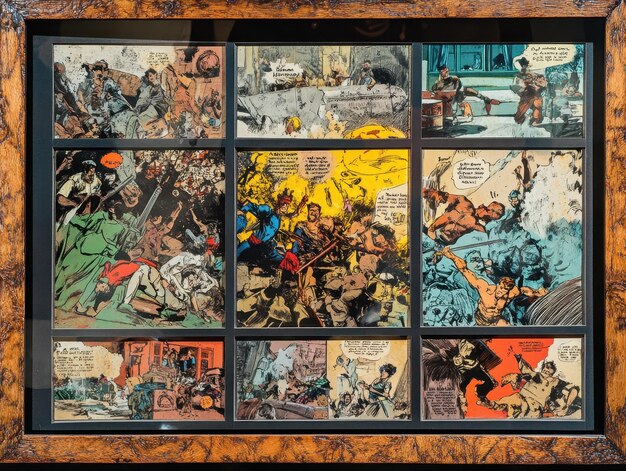US Comic Book Investing: Spotting Rare Issues Worth $500+

US Comic Book Investing 101: How to Spot a Rare Issue Worth Over $500 boils down to understanding key factors like condition, rarity, historical significance, and provenance, alongside market trends and expert advice, to identify valuable comics that can appreciate over time.
Want to turn your comic book hobby into a profitable venture? US Comic Book Investing 101: How to Spot a Rare Issue Worth Over $500 offers a comprehensive guide to identifying, assessing, and investing in valuable comic books. Learn the secrets to spotting those hidden gems that can appreciate significantly over time.
Understanding the Basics of Comic Book Investing
Comic book investing has evolved from a niche hobby into a recognized asset class. Grasping the fundamentals is crucial before diving in. This involves understanding the demand and supply dynamics, the influence of pop culture, and the specific attributes that make a comic book valuable.
Why Invest in Comic Books?
Comics offer diversification in an investment portfolio. They tap into a passion-driven market where emotional investment can drive prices. Rare comics can provide substantial returns, outperforming traditional assets.
Key Factors Influencing Comic Book Value
Several elements contribute to a comic’s worth. These include condition, rarity, age, and significance to comic book history. Collectors and investors meticulously evaluate these factors.
- Condition: Evaluated using grading scales (like those from CGC or PGX). Higher grades ensure better preservation and greater value.
- Rarity: Based on print runs, distribution, and surviving copies. Limited editions or promotional issues are particularly prized.
- Historical Significance: First appearances, key character deaths, or important storylines often increase demand and value.
- Provenance: The documented history of ownership can add to a comic’s allure and credibility.
Understanding the basic principles surrounding comic book investing, such as fundamental value factors and market awareness, provides a solid groundwork to further refine your approach in selecting and trading comic books.
Assessing Comic Book Condition: Grading is Key
The condition of a comic book is paramount to its value. Grading by reputable companies like CGC (Certified Guaranty Company) and PGX (Professional Grading eXperts) provides a standardized assessment. Understanding grading scales and what to look for is crucial.

Understanding the Grading Scale
Grading scales range from 0.5 (Poor) to 10 (Gem Mint). Higher grades command exponentially higher prices. Minute imperfections can significantly impact a comic’s grade.
Common Condition Issues that Affect Grading
Many factors influence comic book grading, including creases, tears, stains, and fading. Professional grading assesses each of these and provides a composite score.
- Creases and Folds: Diminish the overall appeal and are a primary factor in grade reduction.
- Tears and Missing Pieces: Substantially lower value, especially for significant tears.
- Stains and Discoloration: Affect visual appeal and can be caused by moisture, handling, or storage.
- Spine Rolls and Misalignment: Structural issues that show wear and affect overall integrity.
A strong understanding of grading systems is important for collectors and investors to make informed decisions regarding comic book valuations and ensure that personal assessments align with professional expectations.
Identifying Rare Comic Book Issues
Rarity is a primary driver of value in comic book investing. Identifying truly rare issues involves understanding print runs, variants, errors, and distribution oddities.
Understanding Print Runs and Distribution
Comics with low print runs or limited distribution are inherently rarer. Knowing production numbers can help identify potentially valuable issues.
Spotting Variants and Error Editions
Variants (alternate covers) and error editions often have limited availability, making them highly sought after. Identifying them requires a keen eye and knowledge of comic book production history.
- Variant Covers: Often distributed as incentives for retailers, they can be highly collectible.
- Error Editions: Mistakes in printing or binding can create unique collectibles.
- Limited Distribution: Comics only available in certain regions or through special channels can attain higher value.
The ability to distinguish between common and truly rare comics is an important asset in comic book investing. This knowledge guides critical purchase decisions and can reveal opportunities for profit in unique and undervalued comic books.
Key Comic Book Series and Issues to Watch
Certain comic book series and specific issues have historically performed well in the investment market. Knowing which ones to watch can guide your investment strategy. These often include key first appearances, milestones, and culturally significant stories.

Action Comics #1 (1938)
The first appearance of Superman makes this comic incredibly valuable. Its historical significance always keeps it in demand.
Amazing Fantasy #15 (1962)
Featuring the debut of Spider-Man, this comic is a cornerstone of the hobby. Its cultural impact makes it a top investment piece.
Detective Comics #27 (1939)
The first appearance of Batman secures this comic’s place among the most valuable issues ever. Its origin story is a major draw for collectors.
By concentrating efforts on comic books with a strong history and lasting popularity, investors have a better opportunity to experience positive returns due to sustained demand and constrained supply, strengthening their portfolio of comic book assets.
Where to Buy and Sell Comic Books
Navigating the comic book market requires knowing the best places to buy and sell. Options range from local comic shops to online auctions and specialized marketplaces. Each offers unique advantages and considerations.
Local Comic Shops and Conventions
Local shops provide hands-on evaluation and expert advice. Conventions offer larger selections and opportunities to network with other collectors.
Online Auctions (eBay) and Marketplaces
eBay and specialized marketplaces like GoCollect provide access to a global market. They offer a wide range of inventory but require careful vetting of sellers.
- eBay: Offers a broad selection but requires due diligence to avoid counterfeits or misrepresented products.
- GoCollect: Specializes in tracking comic values and connecting buyers with reputable sellers.
- ComicConnect: Known for high-end auctions and a stringent verification process.
Choosing the right venues and platforms can transform the investing experience by providing access to more opportunities, decreasing the risk of fraud, and optimizing returns through calculated purchase and sale strategies.
Avoiding Pitfalls and Protecting Your Investment
Comic book investing comes with potential pitfalls. Protecting your investment involves avoiding scams, understanding market fluctuations, and proper storing your comics.
Recognizing Scams and Counterfeits
Be wary of deals that seem too good to be true. Authenticate high-value comics through reputable grading services.
Understanding Market Trends and Fluctuations
Keep abreast of market trends to make informed buying and selling decisions. Comic values can fluctuate based on movie releases, character popularity, and broader economic factors.
Proper Storage and Preservation Techniques
Invest in archival-quality bags, boards, and storage boxes. Store comics in a cool, dry, and dark environment to prevent degradation.
Taking careful measures and gaining an understanding of the market environment can safeguard comic book investments – protecting against loss and maximizing the value of the assets for the long term.
| Key Area | Brief Description |
|---|---|
| 💰 Investing Basics | Understand factors like condition, rarity, and historical significance. |
| 🔎 Grading Standards | Use grading services like CGC or PGX to assess comic condition accurately. |
| 🌟 Key Issues | Focus on Action Comics #1, Amazing Fantasy #15, and Detective Comics #27. |
| 🛡️ Scam Prevention | Always authenticate and research before making high-value comic book purchases. |
Frequently Asked Questions
▼
A comic’s value depends on condition, rarity, age, and historical importance. Key factors include a high grading score and significance in comic history.
▼
Professional grading services, such as CGC and PGX, evaluate condition using a standardized scale. Minor imperfections can substantially affect the grade.
▼
Action Comics #1, featuring Superman’s debut, Amazing Fantasy #15, introducing Spider-Man, and Detective Comics #27, Batman’s first appearance, are highly prized.
▼
Reliable options include local comic shops, conventions, and online marketplaces like eBay, GoCollect, and ComicConnect. Always verify the seller.
▼
Use archival-quality bags, boards, and boxes. Store comics in a cool, dry, dark place to prevent decay and maintain their condition.
Conclusion
Investing in comic books can be both exciting and profitable. By following the insights in this guide, you can increase your chances of spotting those rare issues worth over $500 and build a valuable collection. Always remember to research thoroughly, assess condition, and stay informed about market trends to maximize your investment potential.





